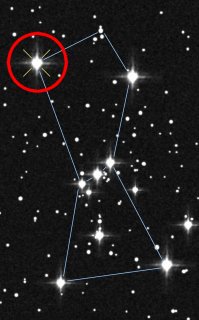“Betelgeuse, Betelgeuse, Betelgeuse!”
 I have to say, the heavens have always been an interest of mine, but not something I would EVER want to pursue a career in. Still, you give me a book about the planets, or the stars or whatever, and I’m a happy guy. I’m also taking this semester at JMU a class on stars and a class on planetary geology in order to fill College of Business non-business-elective requirements. I also took GSCI 104 sophomore year, which is a class that studies the stars as observed by the naked eye, and we learned what stars were in what constellations, and how to find the stars using different stars as pointers, etc. As a side note, I’ve never been able to “see” the different shapes and such that make such-and-such “the twins”, or “the swan”, or what have you (but the Great Square of Pegasus is easy), so I have to say okay, sure. One star that is particularly noteworthy to me is Betelgeuse, in the winter constellation of Orion (circled in red in the star map below). My GSCI 104 professor said, “And this is Betelgeuse (pronouncing it “bay-tull-gice”, rhyming with vice, slice, and nice), or as you all say, Betelgeuse (pronounced “beetle juice”).” I think the fact that Betelgeuse is so interesting to me is first of all, I know where to find it in the sky (it’s the “armpit star” in Orion). Second of all, it’s a red-giant star, and actually shows up red in the sky (kinda cool, you know?). This of course means it’s beyond its regular lifetime as a main-sequence star, and has now ballooned out and is getting ready to end its life. Thirdly, in doing some hunting online at Yahoo for a good star map of the constellation Orion so I could put it up
I have to say, the heavens have always been an interest of mine, but not something I would EVER want to pursue a career in. Still, you give me a book about the planets, or the stars or whatever, and I’m a happy guy. I’m also taking this semester at JMU a class on stars and a class on planetary geology in order to fill College of Business non-business-elective requirements. I also took GSCI 104 sophomore year, which is a class that studies the stars as observed by the naked eye, and we learned what stars were in what constellations, and how to find the stars using different stars as pointers, etc. As a side note, I’ve never been able to “see” the different shapes and such that make such-and-such “the twins”, or “the swan”, or what have you (but the Great Square of Pegasus is easy), so I have to say okay, sure. One star that is particularly noteworthy to me is Betelgeuse, in the winter constellation of Orion (circled in red in the star map below). My GSCI 104 professor said, “And this is Betelgeuse (pronouncing it “bay-tull-gice”, rhyming with vice, slice, and nice), or as you all say, Betelgeuse (pronounced “beetle juice”).” I think the fact that Betelgeuse is so interesting to me is first of all, I know where to find it in the sky (it’s the “armpit star” in Orion). Second of all, it’s a red-giant star, and actually shows up red in the sky (kinda cool, you know?). This of course means it’s beyond its regular lifetime as a main-sequence star, and has now ballooned out and is getting ready to end its life. Thirdly, in doing some hunting online at Yahoo for a good star map of the constellation Orion so I could put it up  here to show you Betelgeuse, I ran across this page at NASA’s Web site, which shows that in 1995, the Hubble Space Telescope captured a shot of Betelgeuse’s disk (seen at the top of this quote), rather than it just appearing as a point of light like when we see it with the naked eye. The only other star we’ve actually seen the disk of is the Sun. The “disk”, BTW, of a star or planet is pretty much what you see when you see the object close enough to make it out nicely, like how you can see the moon’s disk when it’s up at night, because from your vantage point, that’s what it looks like – a disk, just like a CD almost. As mentioned before, Betelgeuse is a red giant star – a supergiant, meaning that it’s REALLY huge. If you were to plop Betelgeuse in the middle of our solar system in place of the sun, it would extend well beyond the orbit of Jupiter. Betelgeuse, when it finishes its supergiant stage, will probably supernova, which means that it will explode, sending most of its mass into space, creating all the elements beyond iron on the periodic table, and leaving a small, dark star in its place. On other Web sites (do a Yahoo search for Betelgeuse if you want to see), there’s speculation whether or not Betelgeuse will eventually become a black hole as its final fate. Back to Betelgeuse’s disk, though – it’s amazing first off that they were able to see the disk of a star 600 light-years away. Secondly, Betelgeuse presented a surprise to the astronomers. While I’m sure they were expecting to find a disk fully red (hence the name “red giant”), surprise! Betelgeuse has a hot spot on its disk – that white area in the middle. It’s like my planetary geology professor said – every time we study something in space and learn something new, our whole knowledge about it changes. A hot spot on Betelgeuse’s disk… an unexpected surprise, indeed.
here to show you Betelgeuse, I ran across this page at NASA’s Web site, which shows that in 1995, the Hubble Space Telescope captured a shot of Betelgeuse’s disk (seen at the top of this quote), rather than it just appearing as a point of light like when we see it with the naked eye. The only other star we’ve actually seen the disk of is the Sun. The “disk”, BTW, of a star or planet is pretty much what you see when you see the object close enough to make it out nicely, like how you can see the moon’s disk when it’s up at night, because from your vantage point, that’s what it looks like – a disk, just like a CD almost. As mentioned before, Betelgeuse is a red giant star – a supergiant, meaning that it’s REALLY huge. If you were to plop Betelgeuse in the middle of our solar system in place of the sun, it would extend well beyond the orbit of Jupiter. Betelgeuse, when it finishes its supergiant stage, will probably supernova, which means that it will explode, sending most of its mass into space, creating all the elements beyond iron on the periodic table, and leaving a small, dark star in its place. On other Web sites (do a Yahoo search for Betelgeuse if you want to see), there’s speculation whether or not Betelgeuse will eventually become a black hole as its final fate. Back to Betelgeuse’s disk, though – it’s amazing first off that they were able to see the disk of a star 600 light-years away. Secondly, Betelgeuse presented a surprise to the astronomers. While I’m sure they were expecting to find a disk fully red (hence the name “red giant”), surprise! Betelgeuse has a hot spot on its disk – that white area in the middle. It’s like my planetary geology professor said – every time we study something in space and learn something new, our whole knowledge about it changes. A hot spot on Betelgeuse’s disk… an unexpected surprise, indeed.
Date posted: February 10, 2002









Leave a Reply